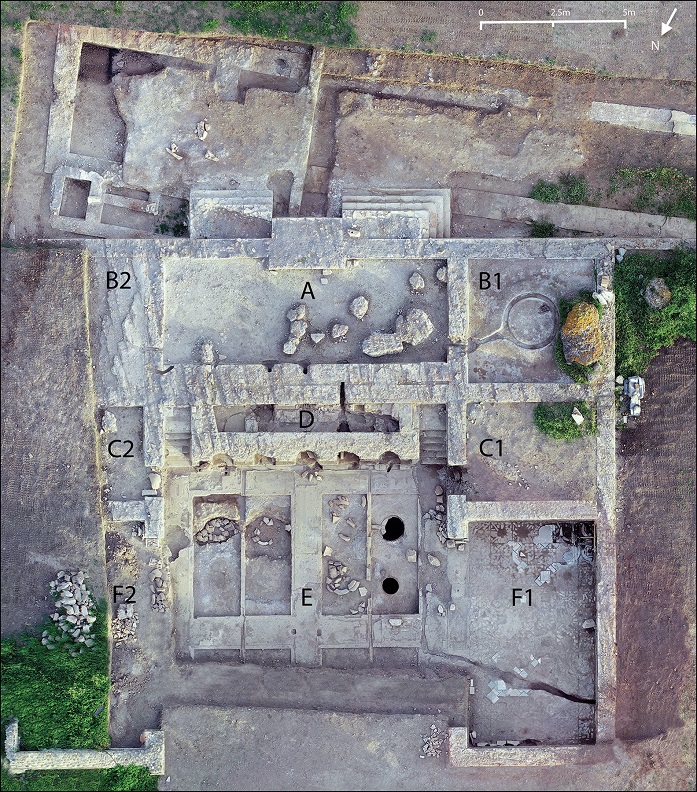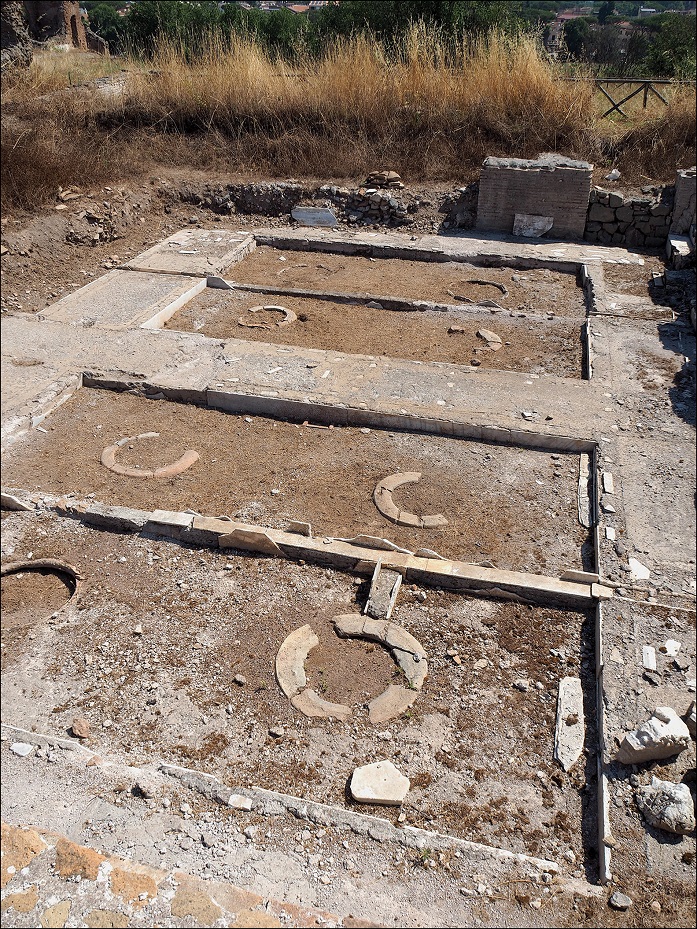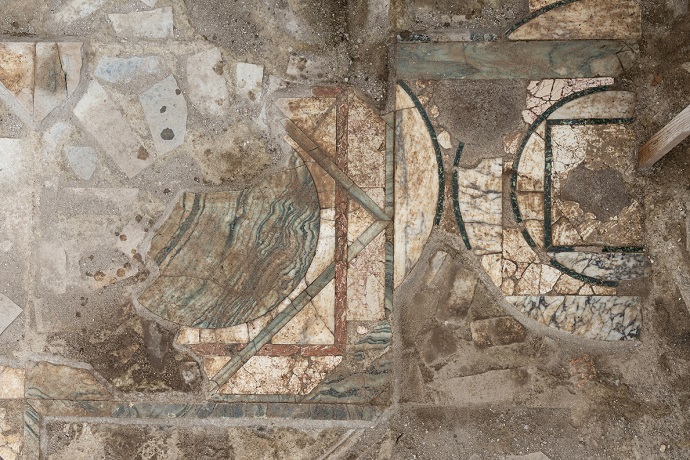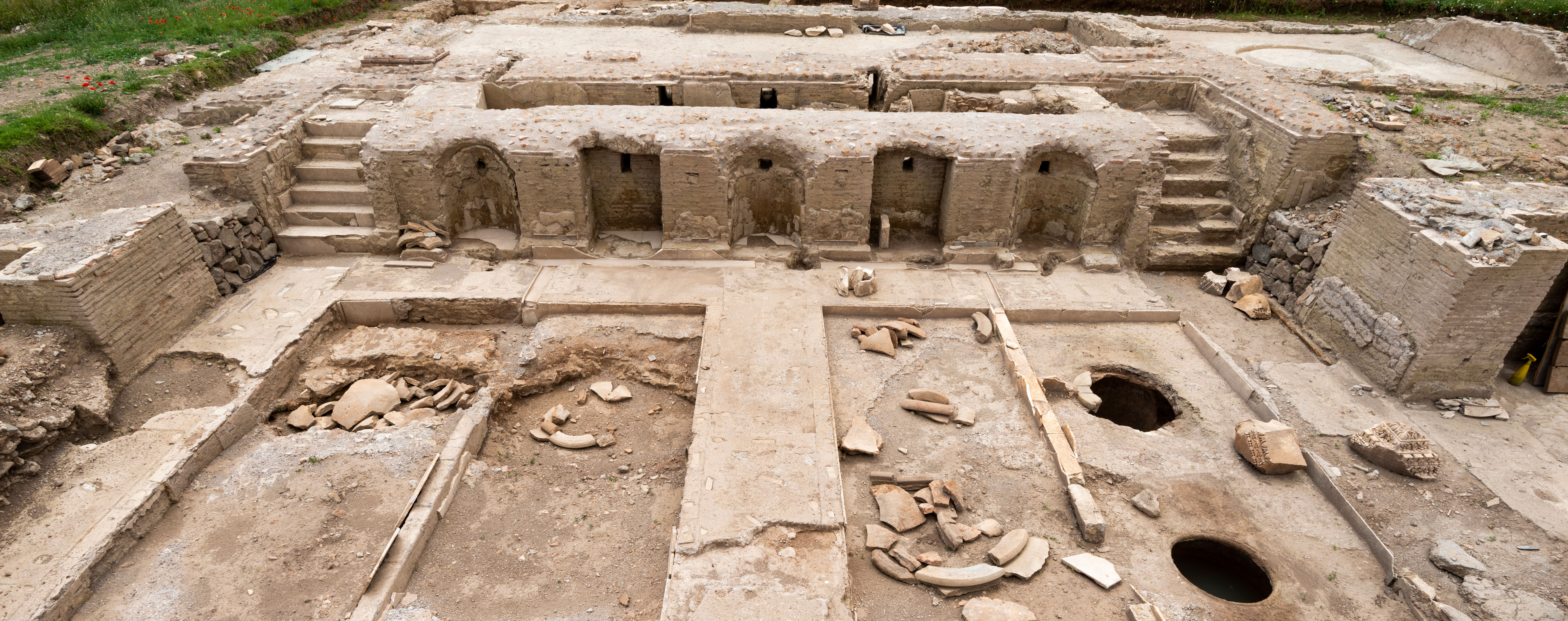Among the answers in the classic scene from Monty Python’s Life of Brian (below) is ‘wine’.
But how was the wine made and what can we learn from the Romans?
Canopy contacted archaeologist Dr Emlyn Dodd FRHistS, an expert on ancient wine production. He’s been studying the ruins of a lavish Roman winery found at the Villa of the Quintilii, on the ancient Appian Way south of Rome.
The excavation shows spaces where wine production was “displayed, observed, flaunted and appreciated,” according to Dodd.
The extravagant winery included luxurious dining rooms with views of the grape-treading areas, two presses… and wine fountains.
Dodd says: “It’s certainly not the usual ancient winery that we find in the Roman era. It’s covered in marble, it’s very decorative, it’s got these theatrical aspects to it – this fountain system. Wine was made using presses and a treading area up top and then it came through this fountain system into the cellar area where it was fermented and stored.... It’s a complete opulent spectacle and a real rarity.”
The Villa of the Quintilii, in the Roman suburbium, is almost a city in miniature, covering up to 24ha. The villa, which dates from the second century AD, had its own orchards and agricultural lands, theatre, an arena for chariot races and a baths complex with walls and floors lined in marble.
The winery was discovered by accident when archaeologists from the Italian ministry of culture tried to find the starting posts of the chariot racetrack, which was built by Emperor Commodus, who had the original owners of the villa, the wealthy Quintilii brothers, killed in AD182-3. The winery, however, is believed to have been built later by the emperor Gordian III, who reigned from AD238-244. The name Gordian is stamped into one of the dolia (clay vats) buried in the ground.
The details
In an article for the scholarly journal Antiquity, Dodd describes the winery’s features: a grape-treading area; two presses; a vat for the collection and settling of grape must; and a system of channels connecting these features to a cella vinaria (wine cellar) with dolia defossa (sunken storage jars). He says these are the features “typical of Roman wineries in several Mediterranean regions”. What sets the winery at Villa of the Quintilii apart is that “their decoration and arrangement are almost unparalleled for a production context in the Roman, and perhaps entire ancient, world”.Treading area

The production process would have begun in the large (11.5 × 4.5m) rectangular treading area (calcatorium) at the building’s southern end (A above). Access for slaves carrying baskets of grapes was probably provided by a door or window reached via two large external brick staircases, which lead up to the south side of the treading area.
“Usually these treading areas would be lined in a waterproof concrete (cocciopesto),” Dodd said. “But these were covered in red breccia marble. Which isn’t ideal, as marble gets incredibly slippery when wet. But it shows that whoever built this was prioritising the extravagant nature of the winery over practical considerations.”
I suggest that marble sounds like it could be a very good, clean material for winemaking production.
Dodd replied: “It’s certainly not a bad surface to use, it’s hygienic and it can be cleaned easily, but it was incredibly expensive and very impractical because of its slipperiness. There were definitely other materials that were prioritised in the vast majority of wineries that were not built by the emperor and did not have the finances of the imperial court behind them. The Romans had this amazing waterproof plaster and concrete that they used everywhere and we find it all the time in ancient wineries. It’s the perfect surface – it’s grippy plaster, you can coat everything in it, providing a waterproof seal. 90% of the wine vats that I’ve worked on across the Mediterranean would be covered in this waterproof plaster, rather than marble.”
Mechanical presses
After treading, the skins would have been placed in baskets made of loosely woven rushes, wound rope, or cloth, or in a wooden framework, and conveyed to the two mechanical presses located to the western and eastern ends of the treading area (B1–B2 above). Only the western press bed (ara) is preserved, with its circular channel (canalis rotunda) that would have collected and conveyed the grape must back into the treading area (see above and main photo). The eastern press was found to be badly damaged by modern ploughing.The western press is of a type that forms part of a distinct mechanical system common across Roman Italy from the second century BC to the fourth and fifth centuries AD. These presses used one of two lever-and-screw mechanisms, though some may have also utilised winches.
The scale of the surviving press bed (approximately 2m diameter) indicates monumentality and the length of the lever required to work the press probably extended beyond the square press room, north over the similarly sized square rooms adjacent to the two narrow staircases (C1–C2 above). These rooms, albeit unexcavated, are also at a lower level – the same as the base of the staircases – facilitating the downward action of a lever press. In such an arrangement, the levers would have been approximately 8-9m in length.
The presence of two large lever presses suggests investment in production of a notable scale but also opens the possibility of diverse qualities, including higher quality wine produced solely by treading and lower quality by pressing. Considering the high-status context of this facility at an imperially owned villa and the possible nature and purpose of production, the symmetrical arrangement of these large presses working in harmony likely contributed to the spectacle of production.
The only other known ancient winery with a theatrical element is Villa Magna, a lavishly decorated winemaking facility 30 miles away to the south-east. There is no evidence of presses here, suggesting that treading was thought to produce a higher quality wine compared with that made by pressing. Dodd told me Romans believed the best quality wine came from “dumping the grapes in a vat and letting the juice seep out on its own accord – naturally – preventing any bitter flavours from skins and seeds getting into the wine. Then they believed that the most common good quality wine was made from treading gently and expressing the juice that way. And then they would gather up all the remaining skins and seeds and stalks and press them multiple times (two or three) which would then produce progressively worse qualities of wine until they soaked the pomace in hot water – re-pressing that to make a very poor quality, low-alcohol wine which was given to slaves and the lowest workers.”
Regarding the grapes that were used, Dodd said: “It’s the great unknown that we don’t have the answer to, but we would like to.”
They are hoping to raise some funds to excavate the other half of the cellar and take some samples from the dolia for residue analysis.
Collection/settling vat and distribution system
Cocciopesto-lined channels conveyed the grape must from the mechanical presses back to the treading floor and then through one of three rectangular openings in its northern wall into a large rectangular collection vat, which was also lined with cocciopesto (D above). This vat, which allowed impurities and unwanted solid materials in the grape must to settle, may have had several compartments to hold must of different qualities.Fountains
After being trodden, the crushed grapes were then taken to the nearby mechanical presses. The resulting grape must was then sent into three fountains, which gushed out of semi-circular niches set into a courtyard wall. There were in fact five fountains, with two outer spouts producing water.Dodd said it “would have created a striking fountain effect as the freshly pressed must poured approximately 1m down into the cella area. The water which passed through the two outermost niches was kept separate from the must by masonry stops and channelled back underground, and, at times, may also have served a cleaning function in the facility.”
The grape must, having cascaded out of the fountains, then flowed along open channels (constructed with mortar and lined with white marble veneer) into large ceramic dolia set into the ground (defossa) – a standard winemaking technique in ancient Rome, since they created a stable microenvironment for fermentation and storage.
I asked Dodd if the fountains were purely decorative or if they had a practical purpose, like aerating the wine?
“This is an interesting idea that I’ve toyed with over and over – whether it was just theatrical,” Dodd replied. “We know that there are these three dining rooms situated around the cellar that offered a view of this fountain structure. So, it clearly was a visual and sensory experience, but whether there was some sort of practical production rationale behind it is an intriguing idea. Aeration is one that I was considering… but I haven’t come to any convincing conclusion yet.”
The cella vinaria

The cella vinaria is positioned in the centre of the winery, with the surrounding rooms focused upon this space (E in the top photo). Just over half of the cella has been excavated; the arrangement of eight dolia defossa is probably repeated in symmetry to the northwest.
Dodd thinks the capacity of 16 dolia makes it a medium-sized facility (Villa Magna’s cella vinaria had 38 dolia). The capacities of the dolia would have ranged from 500-2,000L and their shapes would have been variable – including globular and strawberry shaped with a point at the bottom.
“It’s obviously not your typical farm-villa facility – it’s not producing wine to be sold,” Dodd commented. “So, what were they doing with the wine? Was it kept there for special imperial purposes? It’s all very speculative but it’s interesting to think about.”
He continued: “What’s not so common is that here we have a series of thin white marble-lined channels leading from the fountain area to each dolium individually.”
All but two of the dolia were removed in antiquity; the remaining examples are in a poor condition and show evidence of repair in the form of lead components, including a double dovetail type tie.
During our discussion, I referred to the vats as amphorae. Dodd points out that, to archaeologists, amphorae are the more portable, smaller clay jars used in maritime transport.
Did the winery have a roof?
No tiles or evidence of a roof were identified during the excavations, so Dodd believes it was probably unroofed, although it may have had a cover or velarium, like at Villa Magna.Dining rooms
Covered dining rooms with wide, open entrances that led directly onto the cella were set around three sides of this open courtyard area. Dodd’s hypothesis is that here the emperor would have feasted and enjoyed the full theatrical spectacle of wine production.“Such wide entrances will have provided an expansive view of the interior of the complex and… allowed glimpses of almost all the production stages. The larger, unexcavated room at the north-western end, if it is of the same design and purpose, will have possessed a commanding longitudinal view of the entire facility, like the banqueting exedra at Villa Magna.”

The dining rooms’ walls and floors were covered in multicoloured inlaid marble veneers in elaborate geometrical patterns (above).
It’s all designed to add to the spectacle.
In the Antiquity paper, Dodd wrote: “The facility’s decorative ensemble, highlighted through the use of luxurious materials, was accentuated further when in use – brightly coloured grape must ran through the thin, white marble channels, drawing the observer’s eye up to the façade with its fountains and the treading area above. With the addition of various sounds – workmen joking, laughing or grunting, and the music that accompanied treading – a truly theatrical impression would have been realised.”
Dodd’s hypothesis is that the emperor and his retinue might have visited the Villa of the Quintilii annually to inaugurate that year’s vintage with a ritual and a spectacular banquet.
Letters by a previous emperor, Marcus Aurelius, recount banquets while watching the winemaking. Dodd explained that emperors were interested in wine because “it was such an important product for their society – it was used in medicine, food, religion and everyday consumption – so it completely underpinned Roman culture and society. It was so important they had to pay that kind of respect and that kind of attention to ensure, with their religious hat on, that the harvest was successful, that wine was produced, that the society could use it as they needed to.”













.png)






